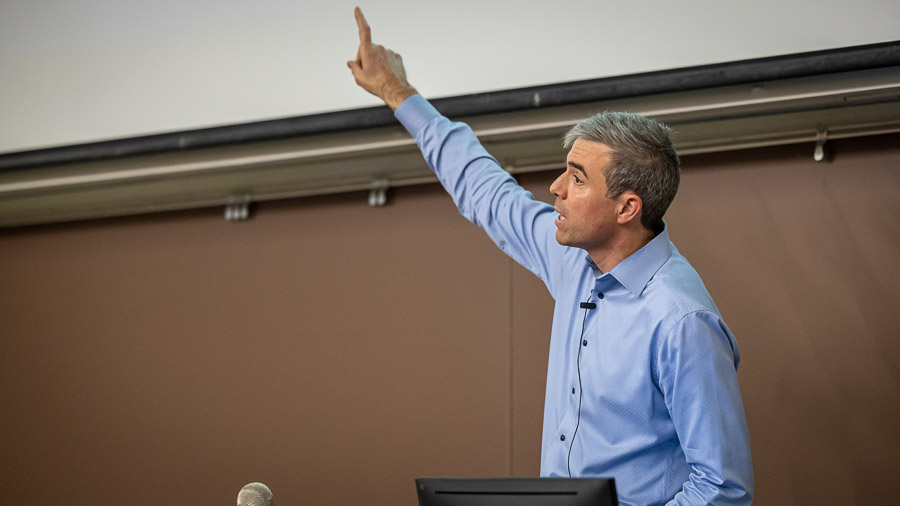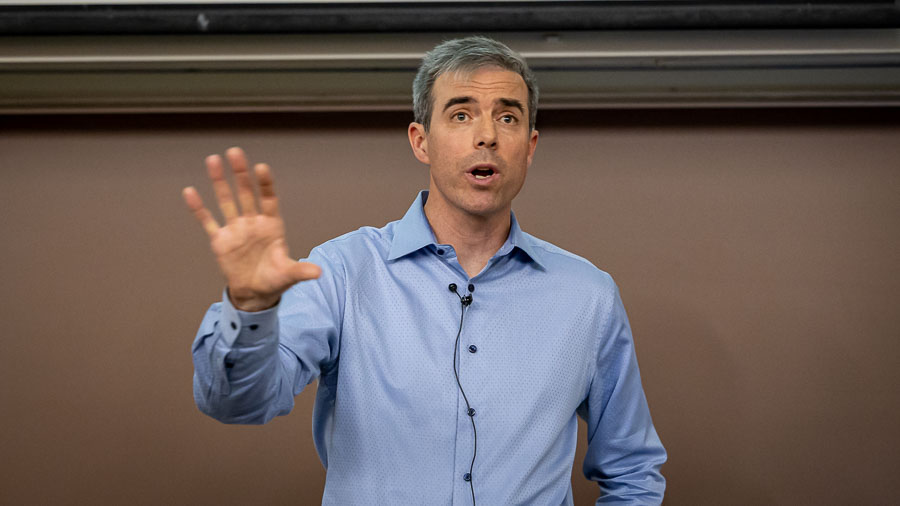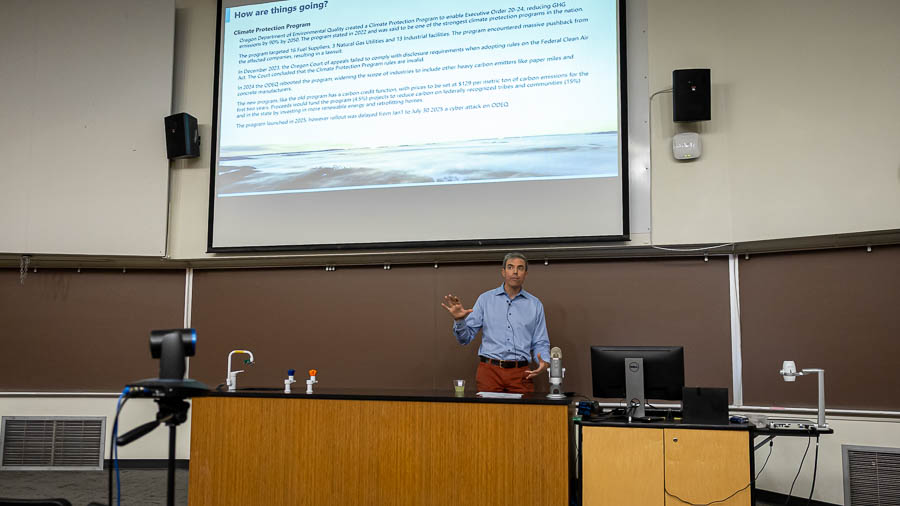By Steven Mitchell for Ashland.news
A Southern Oregon University graduate and executive of a company developing renewable energy projects said the state is making significant strides toward a 100% clean electricity goal by 2040.
Still, challenges remain to change Oregon’s energy infrastructure, according to Erik Steimle, chief development executive of Rye Development, a Portland company.
Steimle, who graduated from SOU in 2000 with a bachelor’s degree in Environmental Biology, said during a university discussion held Friday, May 16 that the state’s three major utility companies — Portland General Electric, Pacific Power, and Idaho Power — are actively working to transition away from fossil fuels, with a mix of wind, solar, and energy storage projects. Key legislative efforts, including Executive Order 20-04 and House Bill 2021, drive the state’s ambitious decarbonization targets. The goal is to reduce greenhouse gas emissions dramatically, with utilities required to reach 100% clean electricity by 2040.

 At the SOU Science Friday lecture, Erik Steimle said Oregon is at the forefront of renewable energy adoption nationwide. Ashland.news photo by Bob Palermini.
At the SOU Science Friday lecture, Erik Steimle said Oregon is at the forefront of renewable energy adoption nationwide. Ashland.news photo by Bob Palermini.
“Our legislation was looked at as very aggressive and possibly the way that we need to approach reducing greenhouse gas emissions at a state level,” Steimle said.
While Oregon’s legislation was initially regarded as the “bright shining object on the hill,” challenges that include where to put power lines to transmit energy and development and permitting costs, among others, complicate the path forward, Steimle said.
Steimle noted that Oregon currently has some of the lowest electricity rates in the world, primarily due to existing hydropower infrastructure, but rate increases are anticipated as the grid transforms. Hydropower is a renewable energy resource that uses the force of moving water to generate power. In 2021, hydropower made up almost 40% of Oregon’s electricity sources, according to a report from the state’s Department of Energy.
Steimle said rural communities have emerged as critical players in transitioning to clean energy, with renewable energy projects offering economic benefits through increased tax bases. He said renewable projects in solar and wind projects in Lake and Sherman Counties have been “transformational” to those communities and created “generational wealth.”
Still, he said, “valid” concerns have arisen from local tribes and the fishing industries regarding storage and transmission of energy.
Rye Development’s pumped storage hydropower project northeast of Klamath Falls faced opposition from local Klamath Tribes, according to reporting from OPB. Local tribes were concerned about the potential damage the project’s construction might pose to culturally significant lands. The Federal Energy Regulatory Commission approved the project last year. It is set for commercial operation in 2028, according to the project’s website.
The project near Klamath Falls will use two artificial lakes at different elevations. The project would pump water uphill at times when there’s extra power in the grid. When demand is high, the water will run downhill through turbines.
As for the fishing industry, last year, a group of independent fishermen and seafood companies called on Gov. Tina Kotek in an open letter to halt a federal offshore wind energy project. According to the letter, the coalition is concerned about the long term impacts of developing energy offshore and that it could disrupt the marine ecosystem.
Steimle said politics have hobbled federally-owned renewable energy projects. He said that whether it’s a project to store energy or transmit energy through power lines, politics have made it hard to move projects forward. People of all political persuasions do not like transmission or power lines, he said.
“It doesn’t matter if you’re on the red side or the blue side,” he said. “People dislike transmission.”

 Erik Steimle, chief development officer of Rye Development and a 2000 Southern Oregon University graduate, spoke during SOU’s recent Science Friday program. Ashland.news photo by Bob Palermini.
Erik Steimle, chief development officer of Rye Development and a 2000 Southern Oregon University graduate, spoke during SOU’s recent Science Friday program. Ashland.news photo by Bob Palermini.
Wind and solar, he said, require more power lines that sometimes can go “all over the place” to balance the power. He said the “sun doesn’t always shine and the wind is not always blowing.”
With traditional energy sources such as a coal-fired power plant or a nuclear plant, one line typically comes into a city.
He also added that most people don’t want those coal or nuclear power plants, nor do they want solar panels or wind turbines in their backyards.
Steimle said the U.S. needs to get better at “building things” and innovation when it comes to bringing renewable energies online.
“We actually do need to build our way out of this,” he said. At the same time, the U.S. is the most difficult regarding regulations and policies.
He said people cannot expect states like Tennessee or Kentucky to drop coal entirely and immediately replace it with a renewable energy source that can take decades to implement.
Steimle said the role of the universities is to “fundamentally rethink” how to develop projects in their communities.
Reach freelance reporter Steven Mitchell at [email protected]
